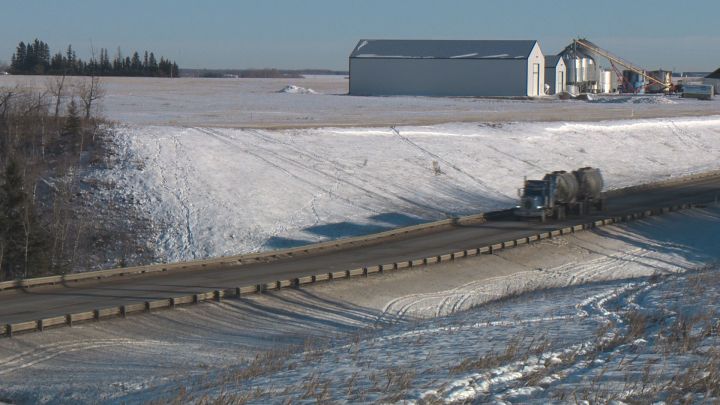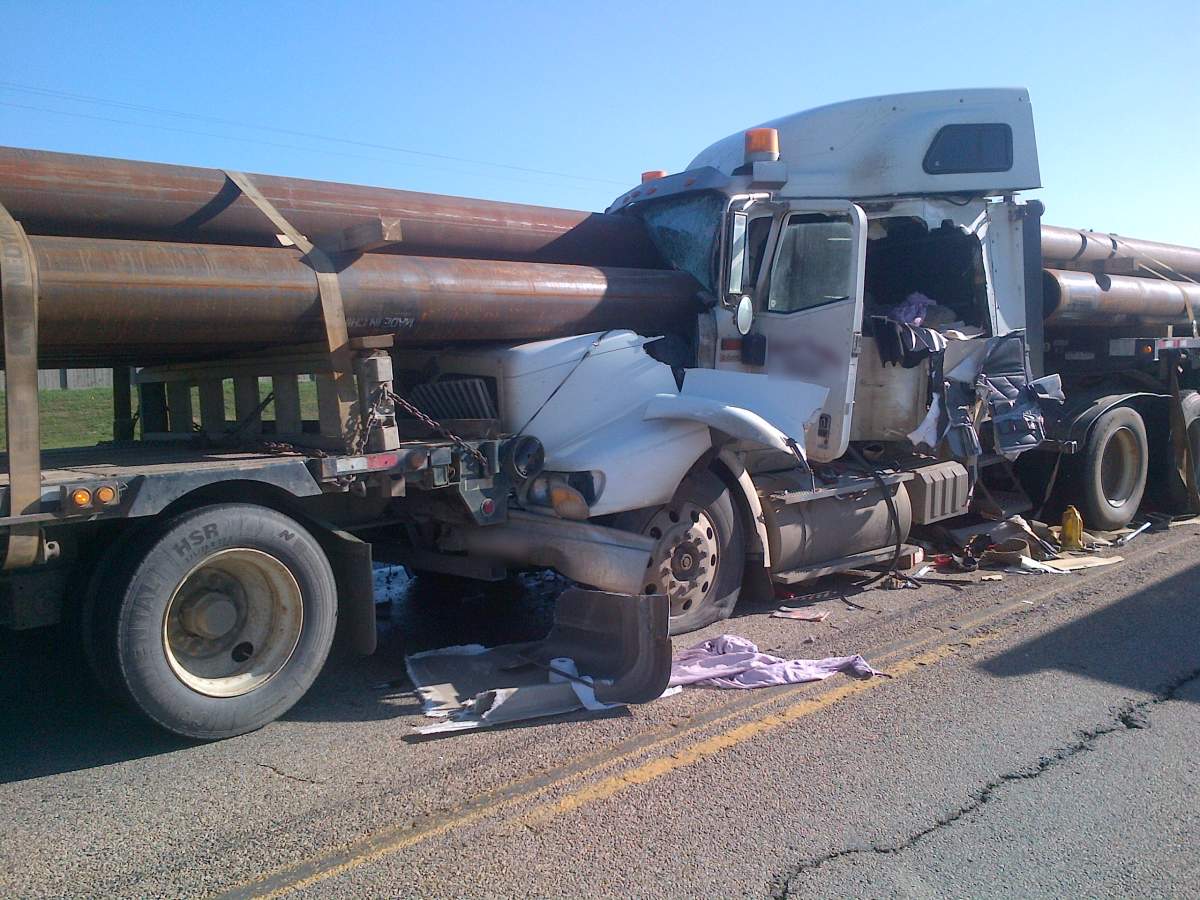A busy and deadly stretch of highway south of Edmonton is one step closer to being fully twinned.

The Alberta government announced upgrades on Monday to the westernmost section of Highway 19, which sees nearly 10,000 commuter and commercial vehicles a day on the 12-kilometre single-lane road between the town of Devon and the QEII.
“Residents take it twice a day, to get to work in Leduc or in Edmonton and then home again at night,” Drayton Valley-Devon MLA Mark Smith said.
The west phase of the project will include 3.5-kilometres of twinning of Highway 19, grade widening on Highway 60 and multiple intersection improvements, including new traffic lights.

“I think it’s safe to say that we are ecstatic,” Devon Mayor Ray Ralph said, explaining the twinning has been one of the town’s priorities since well before he joined council in 2007.
“Many of us have had to commute on Highway 19 on a regular basis and know firsthand how dangerous this highway can be, especially during poor weather.”
The highway has seen many fatal collisions over the years and area residents, including Ralph, have called for the highway to be fully divided for decades.
“We have seen Highway 19 in the news far too many times over the years for the wrong reasons, and we have lost too many lives on this busy road.”
In the past five years alone, there have been 223 crashes on Highway 19: 166 serious property damage collisions, 81 resulting in injuries and several fatalities, including a March 2018 crash that killed one man and another crash in December of that same year which left two other men dead.

The December crash happened at a dip in the road, where it passed over a ravine near Devon.
“We need to make improvements,” Transportation Minister Ric McIver said Monday while speaking at the Town of Devon office. “This highway is a key high-load corridor, which is a big contributor to the provincial transportation network.

Get daily National news
“As our communities and our economy grows, traffic will only increase.”
The road is a common bypass route for truckers avoiding the city, and it isn’t uncommon to see passenger vehicles making risky passes around semi-trucks.
“Heavy industry is a major user of Highway 19, as part of Alberta’s transportation network,” Smith said.
“Trucks carrying parts for manufactured goods or finished products themselves, freight or machinery related to oil and gas are a frequent sight on Highway 19 — especially as they turn onto Highway 60 or vice versa.”
Monday’s announcement marks Phase 2 of a three-step plan to upgrade the entire road.
The first phase saw the twinning of a two-kilometre stretch on the easternmost section of the road near the Edmonton International Airport, between the QEII and Range Road 253 at Castrol Raceway.
That phase, which was completed in September 2019, included the movement of the northern entrance to the airport, as well as new intersections controlled by lights.
Beginning this spring, Phase 2 will twin the other end of the road — between the intersection with Highway 60 and Range Road 261 — which is at the top of a ravine where one of the fatal head-on crashes happened in 2018.
“Twinning Highway 19 will greatly improve safety,” McIver said. “Separating the eastbound and the westbound lanes will reduce the chances of head-on collisions and protect the lives of every person who uses this road.”

Phase 2 is expected to cost about $79 million, with the federal government putting in $27.7 million, the province covering $48.9 million and the Town of Devon contributing $2.2 million.
Highway 19 is a priority transportation corridor, said McIver and parliamentary secretary Larry Bagnell, who spoke Monday on behalf of federal Infrastructure Minister Catherine McKenna.
“The project supports local trade and service by providing better ways of getting around, notably to and from the airport,” Bagnell said.
- RCMP union cuts into Alberta Next Panel for ‘politically driven’ recommendation to shed Mounties
- Vancouver Whitecaps to settle fan lawsuit claiming Messi no-show
- What’s ahead for Lululemon in 2026 amid stock, CEO and investor questions?
- Most Canadians want their cars made domestically, KPMG survey shows
Phase 2 is expected to be completed by the fall of 2022. The province said the construction project will create approximately 400 jobs.
“Twinning will also create more room for industrial and commercial traffic and increase capacity to move oversized loads along a critical, vital commercial corridor,” McIver added.
Devon’s mayor said on top of the commitment for the western expansion, the town has also invested over $7.5 million into other local infrastructure around Highway 19, with the goal of attracting new services and amenities to the town just southwest of Edmonton.
While other communities in the area — such as Stony Plain, Spruce Grove, Leduc and Beaumont — have expanded rapidly in the past two decades, Devon’s growth has been slower.
“While saving lives is all of our top priority, this project also opens the door to new opportunities for Devon as we continue working hard to grow our community,” Ralph said Monday.
The final phase of the Highway 19 twinning will see the middle section divided between Range Road 261 and Range Road 253.
The province said planning for twinning that seven-kilometre stretch was completed in March 2018 and now detailed design, utility relocation, land acquisition and environmental permitting activities are underway.

McIver also provided an update Monday on several upgrades to Highway 60, which runs north of Calmar, through Devon and Parkland County to the Yellowhead, west of Edmonton.
He said that work will includes rehabilitating the deck of the bridge over the North Saskatchewan River near Devon.
There’s also preliminary work underway to twin Highway 60 through the Acheson Industrial Park, including building an overpass at the CN Rail tracks, realigning the nearby Highway 16A overpass to accommodate a second bridge and twinning the remaining segment of the highway through Acheson.
“Now and in the future, all in all, these upgrades will make Alberta’s highway system even more efficient once it’s completed. But just as importantly, that the highway system will be safer.”











Comments